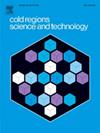In-situ icing and water condensation study on Ni scaffold promoted liquid-infused surfaces
IF 3.8
2区 工程技术
Q1 ENGINEERING, CIVIL
引用次数: 0
Abstract
Ice protection related applications have raised notable academic and industrial attention in recent years. The induction of icephobicity primarily involves the modification of surface characteristics and inherent material properties. One of the significant factors influencing the icephobicity is the surface roughness, as the presence of surface rough asperities may serve as the potential ice anchoring points, especially under high humidity conditions. In this work, the Observation of in-situ water condensation and icing was undertaken on Ni/PDMS icephobic surfaces with varying surface topographies to enhance comprehension of water condensation and ice formation patterns under controlled humidity, pressure, and temperature conditions. It was noted that the surface topography exerts a substantial influence on the water micro-condensation, ice formation and retraction processes. The water micro-condensation normally occurs along the rougher asperities of the sample surfaces. The subsequent analysis indicated a more severe and intensified ice interlock on rougher surfaces. While on smoother surfaces, the lack of capacity to induce anchoring resulted in the reduced observed ice, facilitating a more straightforward ice retraction process. The findings indicated a noteworthy correlation between the dislodgment of ice and interlocking mechanism stemming from the surface rough voids, emphasizing the significance of taking these factors into account in the design and fabrication of ice-repellent surfaces.
镍支架促进液注入表面的原位结冰与水凝结研究
近年来,冰防护相关应用引起了学术界和工业界的广泛关注。疏冰性的诱导主要涉及表面特性和材料固有特性的改变。影响疏冰性的重要因素之一是表面粗糙度,因为表面粗糙的凹凸不平可能成为潜在的冰锚点,特别是在高湿条件下。在这项工作中,在不同表面形貌的Ni/PDMS疏冰表面上进行了原位冷凝水和结冰的观测,以增强对受控湿度、压力和温度条件下冷凝水和结冰模式的理解。研究指出,地表地形对水微凝结、冰的形成和缩回过程有重要影响。水微凝结通常发生在粗糙的试样表面。随后的分析表明,在粗糙的表面上,冰联锁更为严重和强化。而在光滑的表面上,由于缺乏诱导锚定的能力,导致观察到的冰减少,从而促进了更直接的冰收缩过程。研究结果表明,冰的移动与表面粗糙空洞产生的联锁机制之间存在显著的相关性,强调了在设计和制造防冰表面时考虑这些因素的重要性。
本文章由计算机程序翻译,如有差异,请以英文原文为准。
求助全文
约1分钟内获得全文
求助全文
来源期刊

Cold Regions Science and Technology
工程技术-地球科学综合
CiteScore
7.40
自引率
12.20%
发文量
209
审稿时长
4.9 months
期刊介绍:
Cold Regions Science and Technology is an international journal dealing with the science and technical problems of cold environments in both the polar regions and more temperate locations. It includes fundamental aspects of cryospheric sciences which have applications for cold regions problems as well as engineering topics which relate to the cryosphere.
Emphasis is given to applied science with broad coverage of the physical and mechanical aspects of ice (including glaciers and sea ice), snow and snow avalanches, ice-water systems, ice-bonded soils and permafrost.
Relevant aspects of Earth science, materials science, offshore and river ice engineering are also of primary interest. These include icing of ships and structures as well as trafficability in cold environments. Technological advances for cold regions in research, development, and engineering practice are relevant to the journal. Theoretical papers must include a detailed discussion of the potential application of the theory to address cold regions problems. The journal serves a wide range of specialists, providing a medium for interdisciplinary communication and a convenient source of reference.
 求助内容:
求助内容: 应助结果提醒方式:
应助结果提醒方式:


